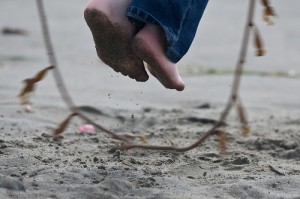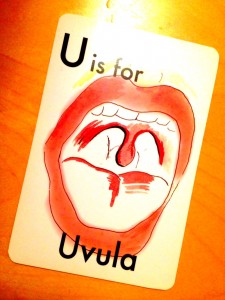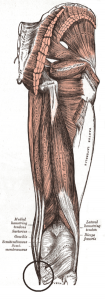 A science writer friend gave me these great nerdy baby flash cards when my older son was born. I’ve been hoarding them for myself until they got discovered last week—hoarding them both because they’re charming (and for the moment, unsullied) and because once they were spotted, I would have to start explaining what each one meant.
A science writer friend gave me these great nerdy baby flash cards when my older son was born. I’ve been hoarding them for myself until they got discovered last week—hoarding them both because they’re charming (and for the moment, unsullied) and because once they were spotted, I would have to start explaining what each one meant.
And so now we are studying the alphabet. A is for atom. D is for diurnal. (What’s diurnal? What’s nocturnal? Oh, nocturnal is like Mommy.)
The one that’s attracted the most interest is U. U is for uvula: even if you’re four, it seems, the word seems vaguely forbidden and completely irresistible. Uvula, uvula, uvula. (Here’s a shaky video from the National Uvula Association.)

What’s it for? my son asks. While the uvula is still a bit of a mystery—in other creatures, a small, underdeveloped uvula was only found in two baboons—it may help in keeping the throat lubricated.
I was trying to think of something else clever to write about the uvula, but every time I looked it up, I was faced with far too many intimate photos of the inside of people’s mouths. (Uvulas can become infected and swell; some are naturally divided, shaped like tiny hearts). The one thing that made me smile above the squeamishness was the etymology: the word comes from the Latin word for grape.
Interesting anatomical names have been on my mind, recently. I’ve been using the interwebs for my other favorite pastime, besides looking up questions for my son that I should probably know the answer to—you guessed it, it’s self-diagnosis of minor injuries.
One of my knees has been aching after I’ve been running, and with a few clicks of the mouse (along with a trip to the PT), I think I have something called goosefoot bursitis. The goosefoot, or pes anserine, is the name of the meeting place of three tendons coming from upper leg muscles: the sartorius, gracilis, and semitendinosus. The way they meet, on the inside edge of the tibia (the Latin word for both shinbone and flute), must have looked, to someone familiar with waterfowl, like a goose’s plates.

And for me, bursitis—the swelling of the bursa, which might resemble the wine sacks they’re named after—is what’s likely causing the problem. (And perhaps a little wine wouldn’t hurt while I’m sitting on the couch with a bag of frozen peas between my knees.)
Ancient Rome and Greece are responsible for many anatomical names. The atlas, the topmost bone of the cervical spine, holds up the head like the mythological Atlas held up the world. The talus, a bone in the ankle, comes from the word taxillus, a word for dice. Roman soldiers reportedly fashioned dice from this bone in horses. And I do feel like I am gambling each time my ankle misses its footing, as it did this weekend on a bluff-top trail.
Of course, there are many colorful ways to describe body parts, both new and old—and there’s something delightful about coming across unfamiliar words for all the things that move me through the day. (I only wish I could talk in thieves’ cant or Cockney rhyming slang all the time.) At the very least, thinking of my troublesome biscuits and cheese makes a few rest days seem more fun.
**
Images Top: Mike Baird Bottom: Wikimedia
One thought on “From Atlas to Plates of Meat”
Comments are closed.